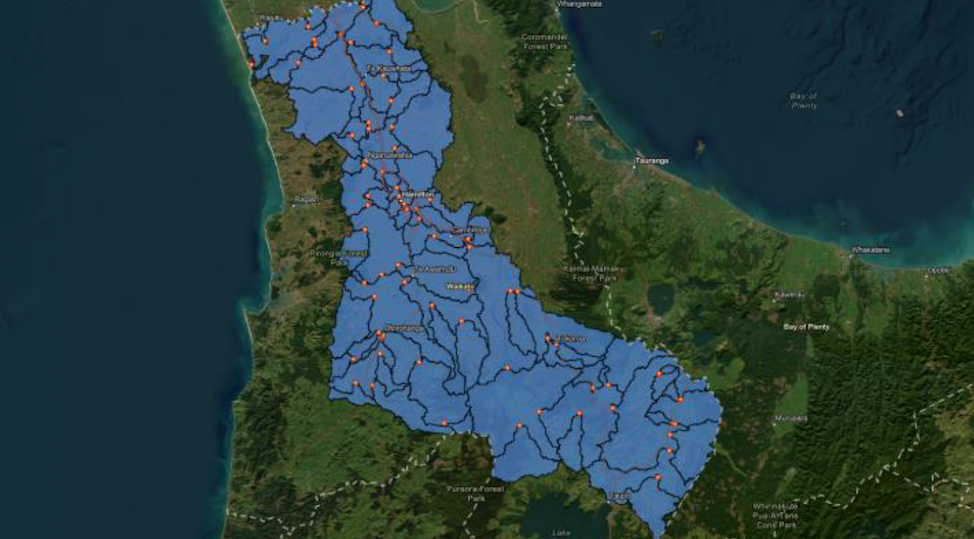An opinion piece by Antony Wyborn, non-executive director, Eco Detection.
Verified water sub-catchment measurement may help solve environmental land degradation.
To meet today’s stringent environmental requirements, multinational food companies and retailers must demonstrate sustainable food and fibre procurement to increasingly environmentally conscious consumers and regulators.
A potential economic solution is to utilise the scale of the catchment hydrology area to incentivise significant environmental positive outcomes at scale through hyper-local resource and land management dictated by the local landowner, farmers and growers.
As many people are becoming aware, the freshwater quality and nutrient pollution load trend at the sub-catchment/catchment level is the single best gauge to measure the sustainability of a given location at scale. This is because water is a universal solvent influenced by gravity, so it can dissolve and transport many substances such as pollution downstream, allowing scientists and engineers to map an upstream, holistic assessment of ecosystem and soil health.
Environmental scientists know that more than half of all species on earth live in the soil – making it the singular most biodiverse habitat on the planet – and that a correctly functioning and healthy soil ecosystem recycles the nutrients within the system rather than losing them through leaching (or dramatically minimises leaching compared to what is currently happening on conventional agricultural soils).
Currently, the global agricultural industry lacks any immediate or financial motivation to demonstrate a yearly measurable reduction in nutrient pollution leaching and runoff, causing land degradation at sub-catchment ecosystem scale. The concept below would help alleviate this issue.
Multinational food companies:
To mitigate the risk of green-washing and stand by sustainability claims, companies should be encouraged to seek and promote raw commodities in their supply chain that are sourced from specific geographical locations worldwide. Locations that can demonstrate that their hydrological catchment area has an annual verified percentage baseline reduction expressed in metric tonnes of total Dissolved Inorganic Nitrogen and Dissolved Reactive Phosphorus (nutrient pollution) that is discharged or leached into its surface freshwater.
So, for example, if a dairy product could be proven to be sourced from an improving freshwater catchment ecosystem, it would demonstrate positive environmental land stewardship at scale and would be perceived as a premium product by the environmentally conscious consumer.
Furthermore, multinational food corporations should financially incentivise farmers/growers collectively by incorporating a Differential Pricing Strategy for raw commodities that factor in environmental outcomes at the catchment/ecosystem level from which these commodities are sourced. That way, again, the collective power of landowners/growers/farmers/industry at scale is incentivised from the ground up to innovate and improve their catchment ecosystem health outcomes, not just for ethical and regulatory reasons, but also for economic reasons.
Verified sub-catchment measurements:
These Verified Measurements could be archived by hydrologists placing in-situ measurement technology at specific locations throughout a catchment to directly measure key freshwater parameters (chemistry). By leveraging autonomous technology over traditional monthly physical water sampling and modelling, a far superior annual baseline can be created to facilitate sustainable food and fibre procurement decision-making.
Farmers and landowners:
My theory is that just like the Champagne region in France, landowners (commonly the most influential) would vigorously defend, lobby for, and protect their catchment ecosystem/region to ensure no further environmental land degradation occurs if a monetary value was attached to it. More importantly, they would take active measures to collectively manage and improve their soil carbon, biodiversity and ecosystem health, emphasising regenerative agriculture principles, in turn reducing GHG emissions.
This would improve freshwater quality, as our most extensive natural water filtration system is a correctly functioning healthy soil ecosystem.
Consumers:
Through the sharing of easy-to-understand information (labelling, PR and advertising), consumers would be able to choose food and fibre products sourced from these improving
ecosystems, thereby enabling a positive feedback loop between the farmer/grower collective and consumers at scale – leading to innovating agricultural practices that produce net positive, measurable environmental outcomes at scale.
Furthermore, socially/politically, this approach could effectively address society’s paradoxical situation where farmers in the Western world (approximately 2% of the western world population) are often blamed for environmental land degradation. At the same time, it is the economic purchasing power of society at large that indirectly supports detrimental agricultural and ecological outcomes to play out at a large scale.
Note: Views expressed are my own. I am curious and passionate about creating a self-propelling positive feedback loop mechanism in the rural sector that benefits the environment, society, and the economy.
Note: I’ve used the term ‘catchment’ (some might use sub-catchment, basin or watershed). This means any large area of land (at scale) in which hydrologists, scientists and engineers can accurately measure the total annual Nutrient Pollution Load discharged/leached into surface water.
